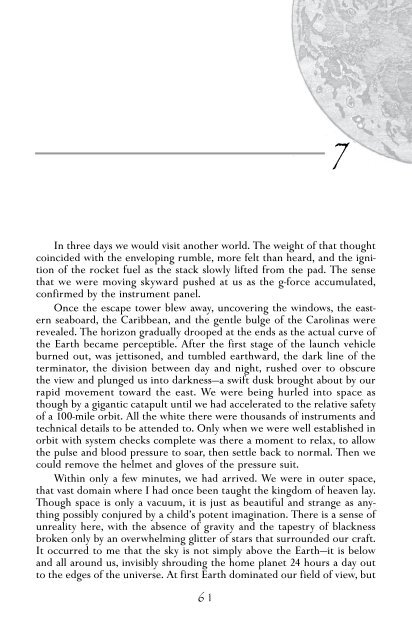edgar-mitchell
edgar-mitchell
edgar-mitchell
You also want an ePaper? Increase the reach of your titles
YUMPU automatically turns print PDFs into web optimized ePapers that Google loves.
Sea of Grass 31<br />
this time in West Newton, Massachusetts, a middle-class residential community<br />
just outside of Boston.<br />
The new program focused on a varied range of subjects never before<br />
studied together. These were bold new topics such as star evolution, galactic<br />
evolution, optimization theory, orbital mechanics, space navigation,<br />
rocket propulsion, inertial platforms—abstruse subjects at the time, often<br />
utilizing primitive, simplistic new theories. No one knew the answers to<br />
the questions they posed, just as no one knew what we would encounter in<br />
the heavens. There were other newly formed curricula similar to this one<br />
at Caltech and Princeton, but by and large, this was a new science, and in<br />
retrospect, our understanding at the time was rather naïve and touching.<br />
Was there life out there And if so, was it benevolent, or malevolent Was<br />
it primitive, or intelligent and evolved to any meaningful degree Only the<br />
most daring or reckless asked such questions, as conventional wisdom,<br />
derived both from science and theology, firmly believed the Earth to be<br />
the biological center of the universe. This naïveté was reflected in the<br />
popular culture of the times as well. The movies of the 1950s and early<br />
’60s are interesting in the way they depict America’s childlike understanding<br />
with unobscured honesty, along with a touch of fear, just as it really<br />
was. In the common mind, heaven was just out there above us, not to be<br />
discovered in this life. It’s easy and self-indulgent to laugh now, but there<br />
was no advantage of hindsight, no view to be had but that brilliant light of<br />
discovery, the source of which lay years in the future. I recall that when I<br />
was a teenager, an alien spacecraft was announced to have crashed near<br />
our ranch in Roswell. A flurry of speculation and gossip followed in its<br />
wake, until the next day, when the official explanation was amended and<br />
the government cited the incident as having been a fallen weather balloon.<br />
Was it More recent events and disclosures reveal the weather balloon<br />
explanation to have been silly and deliberately misleading. These events<br />
were in part what made the times so unbearably exciting.<br />
It was here at MIT that I began to learn about quantum mechanics and<br />
the theory of relativity in an academic forum. The universe was starting to<br />
be explained in ways quite different from the conventional wisdom of<br />
classical physics, and certainly different from the way we perceived it to<br />
be through our senses. I understood that if a person were to one day go to<br />
the moon, the voyager would come back a few microseconds younger than<br />
a twin who had stayed behind. I didn’t yet fully understand that at the<br />
bottom of all matter there was no simple, coherent picture of physical<br />
reality. Though they taught the mathematics of the new physics, the larger<br />
issues and the deeper implications of the theories had not, even then, trickled<br />
down to the ordinary engineering professor. Coming to fully understand<br />
the implications of these notions was years away. Only now, as we<br />
begin the 21st century is there a wider knowledge and new evidence that


